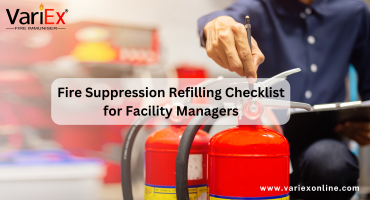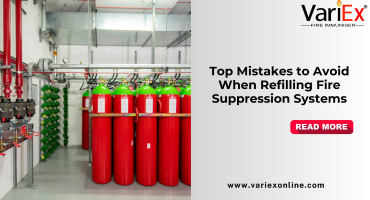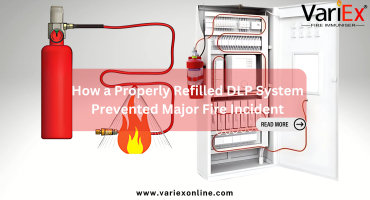![]()
Fire Immuniser
+91-7829629111
Email: info@variex.in
Varistor Technologies Pvt. Ltd.
Block-1, First Floor, Ardente Office One, Hoodi Circle, ITPL Main Road, Bengaluru, Karnataka 560048, IN
What Is Fire Alarm System With Component
What Is Fire Alarm System With Component
In the realm of safety and emergency preparedness, fire alarm systems play a pivotal role. Thousands of residential and commercial properties worldwide depend on these systems to ensure the protection of people and materiel investments, as they promptly detect and alert people about unwanted fire scenarios. This quintessential technological marvel is a housing of numerous fundamental components engineered to seamlessly assist in the detection and alerting of fire occurrences by interpreting environmental changes associated with combustion. Let's delve deeper into the make-up of fire alarm systems and elucidate each component's indispensable function.
What Is A Fire Alarm System?
A fire alarm system is a set of electric/electronic devices working together to detect and alert people when smoke, fire, carbon monoxide, or other emergencies are present. Its primary function is to give an early warning, allowing individuals to evacuate the premises and handle the emergency situation as quickly as possible. Commercial fire alarm systems can be designed to perform additional tasks, such as shutting down HVAC systems to stop the spread of smoke and notifying emergency services. The fundamental difference between residential and commercial fire alarm systems lies in their complexity. Commercial fire alarm systems are designed with a multitude of devices in numerous configurations to meet the unique needs of different businesses and organizations.
Components of a Fire Alarm System
It's important to note that every fire alarm system consists of several integral components which, when working together, create a front-line defense against fires. Let's examine these components and their individual roles more closely.
Fire Alarm Control Panel
Considered the 'brain' of the whole system, the Fire Alarm Control Panel (FACP) receives information from environmental sensors designed to detect changes associated with fire. It monitors these inputs, and when it detects alarming conditions, triggers alarms to alert occupants and possibly emergency services. Additionally, it supplies power to the detection devices and other peripheral equipment. The FACP is highly configurable and can be adjusted to fit the unique safety needs of a given facility.
Primary and Secondary Power Supplies
Every fire alarm system is directly connected to the building's power supply, serving as its primary power source. However, in the event of a power cut, the system can instantly switch over to its secondary power supply, commonly a battery, ensuring uninterrupted operation.
Initiating Devices
These devices are responsible for initiating the fire alarm system during a fire. They include manual pull stations, which allow people to manually trigger the fire alarm system, and automatic detectors, like smoke and heat detectors, which detect changes in the environment associated with fire.
Notification Appliances
Upon receiving signals indicating a fire from the initiating devices, the FACP activates the notification appliances. These include auditory, visual, or combination devices like horns, bells, chimes, strobes, etc. Their primary role is to alert people about the presence of a fire and the need to evacuate the premises immediately.
Building Safety Interfaces
Commercial fire alarm systems often include connections to building systems like the HVAC system or the elevator controls, to ensure these systems respond appropriately during a fire. For example, elevators may be recalled to the ground floor, and HVAC systems may be shut down to prevent the spread of smoke.
Remote Control and Display Panels
These are essentially user interfaces designed for fire department use. They allow responders to acknowledge the alarm, silence the devices, disable affected areas, and reset the entire system once the situation is under control.
Conclusion
In conclusion, a fire alarm system is a complex arrangement of electronic components working together to detect and alert people about the presence of a fire, facilitating swift evacuation and response. Its components, from the central control panel to the initiating devices and notification appliances, all serve individual but complementary roles in ensuring fire safety. The need for a well-functioning fire alarm system cannot be overstressed, considering the vital role it plays in saving lives and property during fire outbreaks. As we become more dependent on technological systems to assure our safety, understanding how these systems function and their components, as discussed in this article, becomes increasingly pertinent.
Final Say
At VariEx.in and VariexOnline.com, we specialize in supplying and installing top-quality fire fighting systems and equipment. From fire extinguishers to advanced suppression systems, we offer comprehensive solutions tailored to your needs. Our experienced team ensures precise installation and maintenance for optimal safety.
Trust VariEx for reliable fire protection. Contact us online or call 7829629111 to learn more.
"WHAT YOU CAN READ NEXT"
 Read more +24 November 2023 in Fire Extinguisher
Read more +24 November 2023 in Fire ExtinguisherWhat types of fire extinguishers are available for different fire classes?
 Read more +28 April 2025 in Fire Suppression
Read more +28 April 2025 in Fire Suppression







